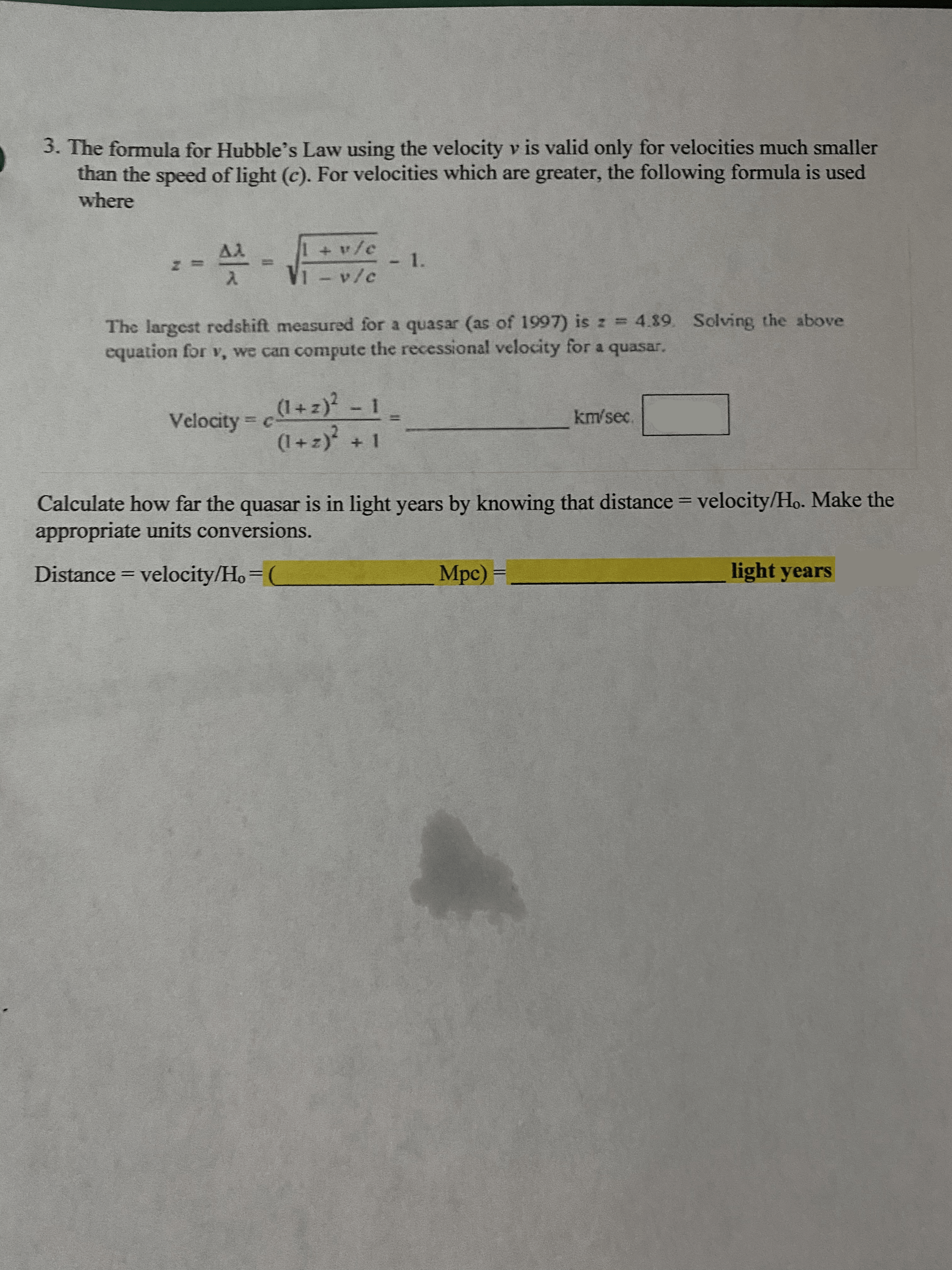Question

Transcribed Image Text:3. The formula for Hubble's Law using the velocity v is valid only for velocities much smaller
than the speed of light (c). For velocities which are greater, the following formula is used
where
1+v/e
- 1.
1-v/c
The largest redshift measured for a quasar (as of 1997) is z = 4.89 Solving the above
equation for v, we can compute the recessional velocity for a quasar.
- 1-
Velocity= +z)² -1
(1+z) + 1
Velocity =
km/sec.
Calculate how far the quasar is in light years by knowing that distance = velocity/Ho. Make the
appropriate units conversions.
Distance = velocity/Ho=C
Mpc) =
light years
%3D
Expert Solution
This question has been solved!
Explore an expertly crafted, step-by-step solution for a thorough understanding of key concepts.
This is a popular solution
Trending nowThis is a popular solution!
Step by stepSolved in 2 steps

Knowledge Booster
Similar questions
- If a galaxy is 9.0 Mpc away from Earth and recedes at 488 km/s, what is H, (in km/s/Mpc)? | km/s/Mpc What is the Hubble time (in yr)? | years How old (in yr) would the universe be, assuming space-time is flat and the expansion of the universe has not been accelerating? years How would acceleration change your answer? O If the expansion of the Universe has been accelerating, the Universe could be substantially younger than the value entered above. O If the expansion of the Universe has been accelerating, the Universe could be substantially older than the value entered above. Need Help? Read Itarrow_forwardOne of our closest stars is our Sun, duh. If the distance from Earth to our Sun is 1.56e-05 light-years, how quickly is that star travelling away from us? [Note that Hubble's Constant is roughly 70 km/s/Mpc and 1 light-year is roughly 3.07E-7 Mpc.] m/sarrow_forwardPlease answer within 90 minutes.arrow_forward
- The hydrogen Balmer line H, has a wavelength of 486.1 nm. It is shifted to 580.7 nm in a quasar's spectrum. What is the redshift of this quasar? (Hint: What is A2?)arrow_forwardPretend that galaxies are spaced evenly, 7.0 Mpc apart, and the average mass of a galaxy is 1.0 ✕ 1011 M. What is the average density (in kg/m3) of matter in the universe? (Note: The volume of a sphere is 4/3pieR^3 and the mass of the sun is 2.0 ✕ 1030 kg.) ______ kg/m^3 Which model universe does this density value support? A: open B: flat C: closedarrow_forward5) The recessional velocity of a galaxy is found to be 0.52c. Calculate the redshift. (2arrow_forward
- Which one of these types of galaxies do you expect to have the largest star formation activity? Select one: ○ a. E7 ○ b. Sc ○ c. Sa ○ d. Sbarrow_forward2. A galaxy cluster has a galaxy behind it whose image we see as being smeared out and curved, with an angular radius of curvature on the sky of θE. The background galaxy is at redshift zgal and the cluster is at zclust. What is the mass of the cluster in solar masses? Give your response in scientific notation with one decimal place. (The Hubble constant is of course 70 km/s/Mpc, and you can assume the Hubble law for these low redshifts). Values: zgal = 0.11 zclust = 0.07 θE = 117.4 arcsecondsarrow_forwardDoes Hubble's Law work well for galaxies in the Local Group (such as Andromeda)? No, because dark energy is accelerating the universe's expansion over those distances. No, because we do not know the precise value of Ho. No, because Hubble did not know the Local Group existed when he discovered his law. Yes, it works well for all galaxies. No, because galaxies in the Local Group are bound gravitationally together.arrow_forward
arrow_back_ios
SEE MORE QUESTIONS
arrow_forward_ios